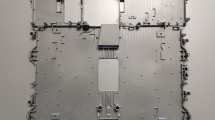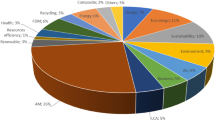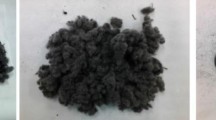Abstract
Additive Manufacturing (AM) as much as sustainability aspects gained increasing attention in the last couple of years. The vision of resource-efficient manufacturing at batch size one is often claimed as an outstanding property of AM. Fused Filament Fabrication, as one of the most used AM technologies, satisfies this statement only in a restricted sense, through simple handling for non-experts and low-cost materials and machines. Next to performance-driven and process-influencing attributes, the question of a general ecological improvement through thermo-mechanical recycling rises. Therefore, recycling options of the thermoplastics are mandatory to explore. Based on the ISO 14040/44 Life Cycle Assessment (LCA) methodology two different geometries were environmentally assessed during a primary process cycle, using, and recycling. Each geometry was manufactured by a bio-based polymer and internationally produced (PLA) and petroleum-based locally produced polymer (PP) with a corresponding support filament. The methodological approach demonstrates an option how to evaluate the field of AM and recycling regarding environmental aspects. Furthermore, an adaption of the sensitivity towards industrial parameters (material/energy efficiency) showed an ecological benefit concerning recycling.
You have full access to this open access chapter, Download conference paper PDF
Similar content being viewed by others
Keywords
1 Introduction
Initial Situation.
Based on a layer-wise material application, Additive Manufacturing (AM) technologies are considered as an appropriate supplement to conventional manufacturing. The steady development of its hard- and software led to a decrease of machines and material investment. The potential around AM seems promising [1, 2]. The AM technology Fused Filament Fabrication (FFF) is characterized by a strand-by-strand positioning of a melted filament through an extruder-nozzle. FFF often sell the image of an ecological conscious technology [3].
Current Problems.
Manufacturing actions are responsible for about 19% (2010) of global greenhouse gases (GHG) [4]. The plastic industry alone emits 8% of all produced GHGs through raw material extraction and energy demand of processing technologies [5]. Annually, 367 Mio. t (2020) of plastic components are produced [6], whereas only 30% of the produced plastic waste are recycled in the European Union. The problems are often referred to a low quality and high price of recycled products, as much as difficulties in systematic collection and sorting processes [7].
Aim of Research.
Closing the gap between ecological assessment and recycling of AM products, quantitative ecological assessment via LCA and thermo-mechanical recycling is implemented. The primary and secondary production (via FFF) is conducted with a bio based internationally produced (PLA) and a petroleum based locally produced (PP) filament for a simple cuboid geometry and additional support structure for a complex blade geometry. In terms of industrial scaling, a sensitivity analysis in consideration of an increased material, process, and energy efficiency is executed.
2 State of the Art
There is a growing interest in the research landscape regarding recycling in terms of waste management, recycling technologies, and recyclability of materials [8, 9]. Despite issues in relation to varietal purity and degradation, thermo-mechanical recycling seems the most promising recycling strategy for mass-focused processing of polymers [10]. Various studies were conducted about the recycling of PLA [11, 12] and PP [13, 14] in the AM context. Primarily, they focus on performance-driven parameters. Most of research regarding AM document technological and economic advantages [15], whereas most of the specific ecological aspects are discussed qualitatively [3, 16], like resource-efficiency, material reduction, minor waste production and production decentralization. A method for ecological assessment is the LCA (ISO 14040/44) [17]. It contains a complex framework for addressing an ecological process analysis and refers to environmental impact indicators [18]. The general integration of LCA in the AM context is proposed in several studies [19, 20], whereas most of the work is presented in specific subfields: There are different research papers concentrating on the energetical characterization [21], hazardous emissions [22], and different applications like automotive [23] and the comparison of conventional and AM manufacturing technologies [24].
3 Materials and Methods
The LCA was executed for a bio based PLA (Premium PLA from Raise3D) with petroleum based PVA (Aquasolve from FormFutura) and petroleum based PP (P-filament 721 natural from PPprint) with the P-support 279 from PPprint.
3.1 Manufacturing, Using State and Recycling Process
The LCA is based on a referenced material extrusion manufacturing process, a simulated using stage and the recycling process (see Fig. 1).
Manufacturing.
The following manufacturing parameters were set on a Raise 3D E2: Extrusion temperature: 210 ℃; print bed temperature: 70 ℃; printing speed: 30 mm/s; part infill: 50%; layer height: 0.2 mm; extrusion: 100%.
Using Stage.
The using state was simulated according to ASTM F1980–16 [25]. The specimens of PLA and PP have been conditioned for 14 days with a temperature of 60 ℃ and a relative humidity of 7.8% in a Carbolite Recirculating drying cabinet PF. These conditions correspond to a usage of about half a year under normal temperature (25 ℃). Mechanical loads, potential containments and wear were not simulated.
Recycling.
For shredding the specimens the SHR3D IT from 3devo was used. The PLA flakes were conditioned in a vacuum oven at 60 ℃ for 24 h before the extrusion process. The Next 1.0 - advanced extruder from 3devo was used with following specifications: extrusion speed: 3 rpm; ventilation: 25%; heating element 1 temperature: 140 ℃; heating elements 2–4 temperature: 180 ℃.
3.2 Specimens
For executing the LCA with an applied and industrial-linked purpose, two different specimens were used Fig. 2.
3.3 Life Cycle Assessment (LCA)
The impact of the processes in terms of ecological aspects was assessed with a standardized LCA acc. to ISO 14040/44 [17]. The methodical procedure proceeded via target and scope definition to data collection in the inventory analysis (Life Cycle Impact Analysis, LCIA). The developed LCA model is shown in Fig. 3 as a reference flow of the functional units (specimens). The foreground system includes all processes that were practically carried out and accompanied within the scope of this work. For conducting the LCIA as a step of the LCA, the ReCiPe Endpoint Method was selected [26]. As credibility reference the Impact 2002 + LCIA method was applied additionally.
3.4 Life Cycle Impact Analysis (LCIA)
The reference flow of the functional unit was broken down into the individual processes and the input and output resources supplied and discharged were listed for each process unit. Primary processes are located in foreground system, whereas non-specific processes and background processes are located in background system.
Origin Material Production.
The data collection regarding primary material production (PP & PLA) was taken from the ecoinvent 3.1 database of the LCA software SimaPro 9 and literature sources. Due to lack of availability of data on PVA granules, polyvinyl chloride (PVC) granules have been used as a substitute material, with the compromise of the missing saponification process. 5% material loss and energy consumption of 1 kWh/kg were assumed [27].
Transportation.
The following transportation settings for PLA were calculated from production facility – container port – container port – parcel hub – final target: (Shangahi, CHN): 329 km (truck Euro 3) – (Hamburg, GER): 19,979 km (trans ocean tanker) – (Feucht, GER): 621 km (truck Euro 6) – (Bayreuth, GER): 79 km (truck). The following transportation settings for PVA were calculated from production facility – parcel hub – final target: (Nijmengen, NL) – (Feucht, GER): 573 km (truck Euro 6) – (Bayreuth, GER): 73 km (truck). The following transportation settings for PP were calculated from: production facility – distribution center – final target: (Frankfurt, GER) – (Bayreuth, GER): 280 km (truck Euro 6) – (Bayreuth, GER): 4 km (truck Euro 6).
Materials and Process.
The data for the packaging of the primary materials was taken from ecoinvent 3.1 and it was assumed that the packaging was disposed of in the general household waste. For pre-processing, PLA was conditioned for 24 h and 60 ℃ in an oven. For pre-treatment, the print bed was cleaned with 2 mL petroleum based cleaner (Pcleaner 298 from PPprint. Due to the energy consumption (<0.001 kWh), the slicing process was not added to the calculation. The rubber mat was cleaned with 2 mL of cleaning gasoline. To remove the PP support structure, the specimen were placed in a drying oven at 110 ℃ for 6 h. The removal of the PVA support was realized by placing the impeller in a covered water bath (1 L) for 24 h.
Recycling.
Before and after the shredding process, the material was weighed and the difference documented as the amount lost and added to disposal. The lab recycling focuses on performance, rather than resource efficiency. This results in more process steps per functional unit, less material and energy efficiency. The industrial recycling follows an economical focus with large-sized machinery. Therefore, the material efficiency is higher and less energy per functional unit is needed. Industrial recycling is composed of an assumed 5% material loss and energy consumption of 1 kWh/kg [27]. Multiple extrusion cycles, re-granulation and cleaning were neglected.
Deposition.
All loss and waste materials were declared as general household waste. The water-soluble polymer solution was also counted among them due to its disposal in canisters. The disposal scenario included the packaging, cleaning, and material losses. Waste disposal was performed by transporting waste from University of Bayreuth to Schwandorf (108 km) with a vehicle (truck Euro 6) is assumed.
4 Results and Discussion
Without focusing on performance or process-influencing properties, all filaments were suitable for reproduction. In order to the guidelines of Life Cycle Interpretation acc. Haunschild et al. [28], it is attempted to identify the significant issues, evaluate the completeness, sensitivity, and consistency and deliver limitations and recommendations of the investigated product and process. All processes including pre-treatment, part fabrication, and post-treatment contain no significant differences in consideration of the same functional unit with the same polymer. These processes can be considered as the most resource-demanding processes and therefore have got the biggest impact on the life cycle. In terms of the PLA cuboid, the extra conditioning of the PLA flakes before the extrusion process and the actual recycling process in form of shredding and extruding surpass (transportation and distribution) the virgin production in all three impact factors (see Fig. 4). As a reference, the linear production was calculated to 148 mPt. The recycling of the PLA cuboid in laboratory (205 mPt) and industrial scale (165 mPt) led to an increase of 37.8% respectively 11.4%. A second LCIA method (Impact 2002 +) confirms the result with a magnitude of 0.344 mPt of the primary process in respect to the 0.395 mPt resp. 0.350 mPt. Due to the absence of the energy-demanding conditioning process and the significantly increased resource efficiency of the simulated industrial scaling an improved impact behaviour of recycled PP with the cuboid specimen could be shown (see Fig. 5). Furthermore, the additional granulating and extrusion process, due to the lack of reprinting qualities at laboratory scale were neglected at the LCA execution at industrial scale.
This is quantified through the lowest impact score of industrial recycled PP (110 mPt) in comparison to linear PP (115 mPt/ + 4.32%) and lab recycled PP (133 mPt/ + 21.5%). The Impact 2002 + LCA pointed out a similar tendency with 0.231 mPt for linear and industrial recycled PP and 0.273 mPt for lab recycled PP (see Fig. 5).
Despite the higher impact (PLA: 2,429 mPt; PP: 947.6 mPt) of the lab recycling, with industrial recycling, the impact of the PLA impeller linearly produced (2,171 mPt) can be reduced by 30.6% to 1,506 mPt and the virgin PP impeller (879.5 mPt) by 26.6% to 645.5 mPt. The calculation with Impact 2002 + for the linear/lab recycled/industrial recycled impeller yielded in similar results for PLA: 6.2 mPt/6.9 mPt/3.2 mPt and for PP: 1.8 mPt/1.6 mPt/1.1 mPt (see Fig. 6).
5 Conclusion
The results show a tendency of the environmental potential of recycling in consideration of extrusion-based production applications regarding human health, ecosystems, and resources. This potential can mainly be exploited if the recycling process is executed at industrial scale esp. with PP. The scaling approach shall elucidate the improved process efficiency regarding materials and energy. Furthermore, the LCA showed that the environmental impact of the petroleum-based PP is significantly lower than with PLA. These differences mainly result from the raw material extraction, energy demands between the varying processes and the waste generation. Furthermore, the recycling of PP and PP support filament led to a waste decrease of approx. 50% regarding the PP impeller. The simulated scaling also showed the decrease of single processes. In general, a scaling of the components mass- and complexity-wise showed the potential of resource-optimized industrial recycling in respect of energy and waste reduction. The industrial recycling demonstrated the sensitivity in energy and waste aspects for the investigated pre- and post-processes. Otherwise, sorting and collecting as well as transportation and distribution process of the virgin material are considered to change the results.
References
Schmitt, P., et al.: Additive Manufacturing research landscape: A literature review. In: Proceedings of the Design Society ICED21. Gotheburg, Sweden (2021)
Tofail, S.A.M., et al.: Additive manufacturing: scientific and technological challenges, market uptake and opportunities. Mater. Today 21(1), 22–37 (2018)
Gebler, M., et al.: A global sustainability perspective on 3D printing technologies. Energy Policy 74, 158–167 (2014)
Diaz, N., et al.: Machine tool design and operation strategies for Green Manufacturing. In: Proceedings of 4th CIRP International Conference on High Performance Cutting (2010)
Kohtala, C.: Addressing sustainability in research on distributed production: an integrated literature review. J. Clean. Prod. 106, 654–668 (2015)
Plastics Europe: Plastics–the Facts 2021; https://plasticseurope.org/wp-content/uploads/2021/12/Plastics-the-Facts-2021-web-final.pdf (2021)
European Parliament, https://www.europarl.europa.eu/resources/library/images/20210727PHT09210/20210727PHT09210_original.jpg last accessed 2022/05/09
Wang, M., et al.: A scientometric review of resource recycling industry. International Journal of Environmental Research and Public Health 16(23) (2019)
Kazemi, M., et al.: State of the art in recycling waste thermoplastics and thermosets and the applications in construction. (2021)
Hopewell, J., et al.: Plastics recycling: challenges and opportunities. Philosophical Transactions of the Royal Society B: Biological Sciences 364(1526) (2009)
Lanzotti, A., et al.: A comparison between mechanical properties of specimens 3D printed with virgin and recycled PLA. In: Proceedings of 12th Confercence on Intelligent Computation in Manufacturing Engineering (CIRP12). Gulf of Naples, Italy (2018)
Tanney, D., et al.: Investigating material degradation thorugh the recycling of PLA in additively manufactured parts. In: Proceedings of the 28th Annual International Solid Freeform Fabrication Symposium (SFF2017). Austin, USA (2017)
Spoerk, M., et al.: Mechanical recyclability of Polypropylene composites produced by material extrusion-based Additive Manufacturing. Polymers 11(8), 1318 (2019)
Vidakis, N., et al.: Sustainable Additive Manufacturing: Mechanical response of Polypropylene over multiple recycling processes. Sustainability 13(1), 159 (2020)
Huang, S.H., et al.: Additive Manufacturing and its societal impact: a literature review. The International Journal of Advanced Manufacturing Technology 67, 1191–1203 (2013)
Garcia, F.L., Moris, V.A.S.: Environmental performance of additive manufacturing process – an overview. Rapid Prototyping Journal 24(7), 1355–1177 (2018)
ISO 14040: Environmental management – Life cycle assessment – Principles and framework (ISO 14040:2006 + Amd 1:2020)
Curran, M.A.: Life Cycle Assessment: a review of the methodology and its application to sustainability. Curr. Opin. Chem. Eng. 2(3), 273–277 (2013)
Saade, M.R.M. et al.: How has LCA been applied to 3D printing? A systematic literature review and recommendations for future studies. Journal of Cleaner Production (244) (2020)
Ribeiro, I., Matos, F., et al.: Good Framework for Life Cycle sustainability assessment of Additive Manufacturing. Sustainability 12(3), 929 (2020)
Baumers, M., et al.: Transparency Built-in. Energy consumption and cost estimation for Additive Manufacturing. Journal of Industrial Ecology 17(3):418–431 (2012)
Bours, J., et al.: Addressing hazardous implications of Additive Manufacturing: Complementing Life Cycle Assessment with a framework for evaluating direct human health and environmental impacts. Journal of Industrial Ecology 21(1) (2017
Böckin, D., Tilman, A.-M.: Environmental assessment of additive manufacturing in the automotive industry. J. Clean. Prod. 226, 977–987 (2019)
Faludi, J.: Comparing environmental impacts of Additive Manufacturing vs. traditional machining via Life-Cycle Assessment. Rapid Prototyping J. 21(1), 14–33 (2015)
ASTM F1980-21: Standard Guide for Accelerated Aging of Sterile Barrier Systems and Medical Devices; (ASTM F1980-21:2021)
Bare, J.C., Hofstetter, P., Pennington, D.W. et al.: Midpoints versus endpoints: the sacrifices and benefits. Int. J. LCA 5, 319–326 (2000). https://doi.org/10.1007/BF02978665
Cerdas, F., et al.: Life cycle assessment of 3D printed products in a distributed manufacturing system: LCA-distributed manufacturing system. J. Ind. Ecol. 21(1), 80–93 (2017)
Hauschild, M.Z., et al.: Life Cycle Assessment. Theory and Practice. Springer Nature, Cham, Switzerland (2017)
Author information
Authors and Affiliations
Corresponding authors
Editor information
Editors and Affiliations
Rights and permissions
Open Access This chapter is licensed under the terms of the Creative Commons Attribution 4.0 International License (http://creativecommons.org/licenses/by/4.0/), which permits use, sharing, adaptation, distribution and reproduction in any medium or format, as long as you give appropriate credit to the original author(s) and the source, provide a link to the Creative Commons license and indicate if changes were made.
The images or other third party material in this chapter are included in the chapter's Creative Commons license, unless indicated otherwise in a credit line to the material. If material is not included in the chapter's Creative Commons license and your intended use is not permitted by statutory regulation or exceeds the permitted use, you will need to obtain permission directly from the copyright holder.
Copyright information
© 2023 The Author(s)
About this paper
Cite this paper
Bay, C., Nagengast, N., Schmidt, HW., Döpper, F., Neuber, C. (2023). Environmental Assessment of Recycled Petroleum and Bio Based Additively Manufactured Parts via LCA. In: Kohl, H., Seliger, G., Dietrich, F. (eds) Manufacturing Driving Circular Economy. GCSM 2022. Lecture Notes in Mechanical Engineering. Springer, Cham. https://doi.org/10.1007/978-3-031-28839-5_75
Download citation
DOI: https://doi.org/10.1007/978-3-031-28839-5_75
Published:
Publisher Name: Springer, Cham
Print ISBN: 978-3-031-28838-8
Online ISBN: 978-3-031-28839-5
eBook Packages: EngineeringEngineering (R0)










